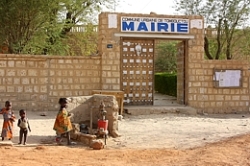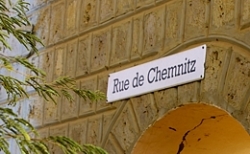Timbuktu (Republic of Mali)
| Twinned since | 1968 |  |
| Population: | 54,400 (2009) |
Timbuktu is an oasis city in the West African state Mali. It lies in the Sahel zone on the southern edge of the Sahara – the advance of which (desertification) creates most of the city’s problems.

Timbuktu lies five kilometres (three miles) from the River Niger and has for centuries been a centre of trans-Sahara trade. Already in the 15th and 16th centuries Sankoré University was a centre of learning in the Islamic world. The three mosques that characterise the cityscape, the Djinguereber Mosque, The Sankoré Mosque and the Sidi Yaha Mosque, as well as 16 cemeteries and mausoleums have been UNESCO World Heritage sites since 1988.
In the 1990s there was a uprising among the Tuareg, which had the goal of declaring their own state. The rebellion was ended in 1966 with a symbolic burning of weapons. The “Flame of Peace” Monument in Timbuktu commemorates this historic peace agreement.

Within the framework provided by the twinning agreement the City of Chemnitz has financed extensive tree planting in Timbuktu, provision of educational materials, an aid shipment with medical equipment and appliances and a solar plant for the regional hospital from donations. For this valuable assistance was provided by the representatives of the German Development Service (DED) on the spot.
Chemnitz supports reconstruction with €10,000 from donations
The mayor out our Malian twin town, Timbuktu, Hallé Ousmane, described the difficult situation in his city after a year4’s occupation by rebels to a council meeting on 17 April 2013. In a moving speech the mayor reported on the suffering of the population during this time; assaults, arrests and torture: refugees, closed schools and a totally destroyed infrastructure. At the same time he told of the efforts to reconstruct public life step by step.
